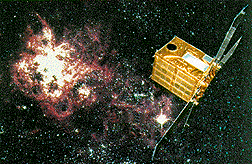 | |
| Names | Astro-C before launch |
|---|---|
| Mission type | X-ray Astronomy |
| Operator | Institute of Space and Astronautical Science University of Tokyo |
| COSPAR ID | 1987-012A |
| SATCAT no. | 17480 |
| Spacecraft properties | |
| Launch mass | 400 kg (880 lb) |
| Start of mission | |
| Launch date | 06:28,February 5, 1987(UTC) |
| Rocket | M-3S2, mission M-3S2-3 |
| Launch site | Uchinoura Space Center |
| End of mission | |
| Decay date | November 1, 1991 |
| Orbital parameters | |
| Reference system | Geocentric |
| Eccentricity | 0.01365 |
| Perigee altitude | 517 km (321 mi) |
| Apogee altitude | 708 km (440 mi) |
| Inclination | 31.1° |
| Period | 97 min |
| Epoch | February 5, 1987 |
ASTRO-C, renamed Ginga (Japanese for 'galaxy'), was an X-ray astronomy satellite launched from the Kagoshima Space Center on 5 February 1987 using M-3SII launch vehicle. [1] The primary instrument for observations was the Large Area Counter (LAC). Ginga was the third Japanese X-ray astronomy mission, following Hakucho and Tenma (also Hinotori satellite - which preceded Ginga - had X-ray sensors, but it can be seen as a heliophysics rather than X-ray astronomy mission). [2] Ginga reentered the Earth's atmosphere on 1 November 1991.